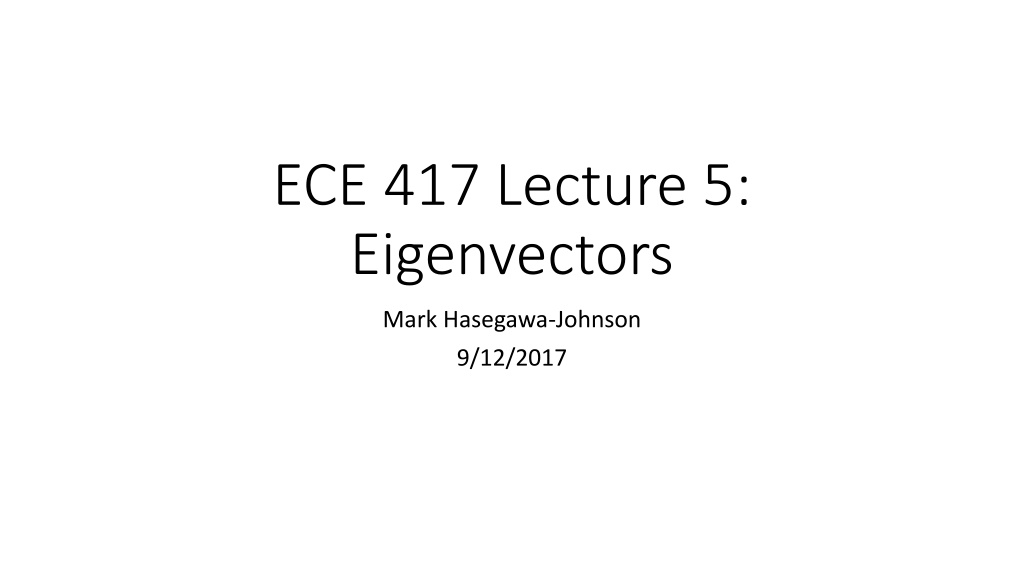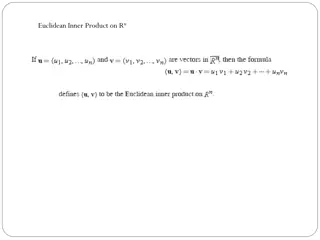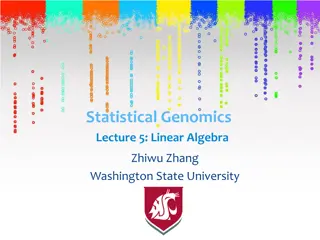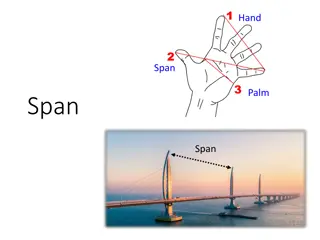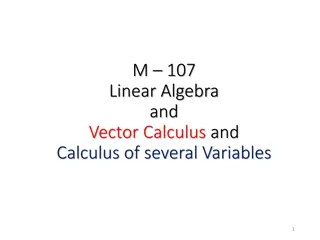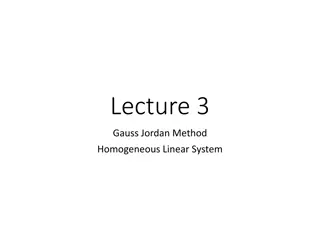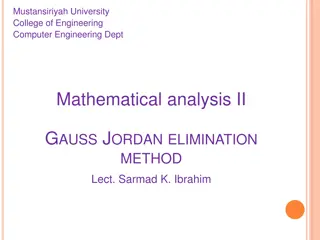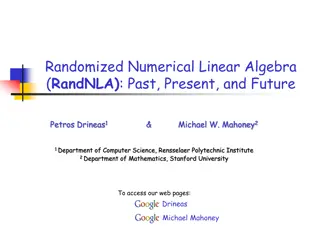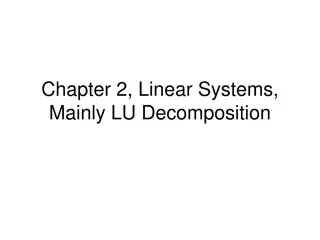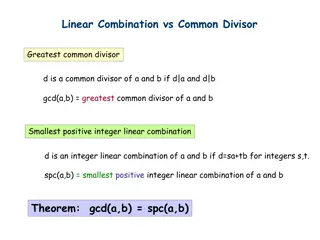Understanding Eigenvectors in Linear Algebra
Explore the concept of eigenvectors in linear algebra, covering topics such as linear transforms, eigenvalues, symmetric matrices, and their practical applications. Learn how eigenvectors represent directions in which a transformation only stretches or compresses without changing direction, and understand the significance of eigenvalues in matrix operations.
Download Presentation

Please find below an Image/Link to download the presentation.
The content on the website is provided AS IS for your information and personal use only. It may not be sold, licensed, or shared on other websites without obtaining consent from the author. Download presentation by click this link. If you encounter any issues during the download, it is possible that the publisher has removed the file from their server.
E N D
Presentation Transcript
ECE 417 Lecture 5: Eigenvectors Mark Hasegawa-Johnson 9/12/2017
Content Linear transforms Eigenvectors Eigenvalues Symmetric matrices Symmetric positive definite matrices Covariance matrices Principal components
Linear Transforms ?2 A linear transform ? = ? ? maps vector space ? onto vector space ?. For example: the matrix ? =1 the vectors 1 2maps ?1 0 1 1 ?1,?2,?3, ?4=1 ,0 2 2 0, 1, ?2 1 1 2 2 to the vectors ?1,?2,?3, ?4=1 0 ,1 2 2 ?1 0, 2, 2
Linear Transforms ?2 A linear transform ? = ? ? maps vector space ? onto vector space ?. For example: the matrix ? =1 the vectors 1 2 1 1 2maps 1 ?1 0 1 0 ?2 2 ? = 1 0 1 2 2 to the vectors ?1 ? =1 2 2 1 2 0 0 2
Linear Transforms ?2 A linear transform ? = ? ? maps vector space ? onto vector space ?. The absolute value of the determinant of A tells you how much the area of a unit circle is changed under the transformation. For example: if ? = 1 1 0 has an area of ?) is mapped to an ellipse with an area of ? ???( ? ) = 2?. ?1 ?2 2, then the unit circle in ? (which ?1
Eigenvectors ?2 For a D-dimensional square matrix, there may be up to D different directions ? = ??such that, for some scalar ??, ???= ???? For example: if ? =1 eigenvectors and eigenvalues are 1 ?1 1 2, then the ?2 0 ?1=1 2 0,?2= ,?1= 1,?2= 2 ?1 1 2
Eigenvectors ?2 An eigenvector is a direction, not just a vector. That means that if you multiply an eigenvector by any scalar, you get the same eigenvector: if ???= ????, then it s also true that ????= ????? For example: the following are all the same eigenvector 1 ?1 1 ?2 , 2?2=1 2 2 ?2= 1, ?2= 1 1 2 2 Since scale doesn t matter, by convention, we normalize so that ?? 2= 1 and the first nonzero element is positive. ?1
Eigenvectors ?2 Notice that only square matrices can have eigenvectors. For a non-square matrix, the equation ???= ????is impossible --- the dimension of the output is different from the dimension of the input. Not all matrices have eigenvectors! For example, a rotation matrix doesn t have any real-valued eigenvectors: ? =cos? sin? ?1 ?2 ?1 sin? cos?
Eigenvalues ?2 ???= ???? ???= ??? ?? ??? ??? ??= 0 (? ???) ??= 0 ?1 That means that when you use the linear transform (? ???) to transform the unit circle, the result has zero area. Remember that the area of the output is ? ? ??? . So that means that, for any eigenvalue ??, the determinant of the matrix difference is zero: ? ??? = 0 Example: ? ?2? =1 0 ?2 ?1 1 2 21 0 1 = 1 1 0 0 0
Eigenvalues Let s talk about that equation, ? ??? = 0. Remember how the determinant is calculated, for example if ? ? ? ? ? ? ? ? ? = , then ? ?? = 0 means that ? ? ? ? ? ? ? ? ? 0 = ? ?? = = ? ? (? ?)(? ?) ? ? ? ? ? ? ?? + ? ? ? ? ? We assume that ?,?,?,?,?,?,?, ,? are all given in the problem statement. Only ? is unknown. So the equation ? ?? = 0 is a D th order polynomial in one variable. The fundamental theorem of algebra says that a D th order polynomial has D roots (counting repeated roots and complex roots).
Eigenvalues So a DxD matrix always has D eigenvalues (counting complex and repeated eigenvalues). This is true even if the matrix has no eigenvectors!! The eigenvalues are the D solutions of the polynomial equation ? ??? = 0
Positive Definite Matrix A linear transform ? = ? ? is called positive definite (written ? 0) if, for any vector ?, ??? ? > 0 So, you can see that this means ?? ? > 0. So this means that a matrix is positive definite if and only if the output of the transform, ?, is never rotated away from the input, ?, by 90 degrees or more! (useful geometric intuition) For example, the matrix ? =1 positive-definite. ?2 ?1 ?2 1 2is ?1 0
Symmetric matrices We ve been working with right eigenvectors: ???= ???? ?, and There may also be left eigenvectors, which are row vectors ?? corresponding left eigenvalues ??: ?? If A is symmetric (? = ??), then the left and right eigenvectors and eigenvalues are the same, because ?? ?? But ?? ?? eigenvalue and eigenvector, as well as right. ?? = ???? ? ?= ???? ?? means that lambda and v satisfy the definition of left ???= ?? ?? ?= ??? ?= ?? ?= ??
positive definite matrices you can do an interesting thing if you multiply the matrix by its eigenvectors both before and after: ?? ??= ?? ??? ?? = ?? ?? 2 2= ?? ?? So if a matrix is positive definite, then all of its eigenvalues are positive real numbers. It turns out that the opposite is also true: A matrix is positive definite if and only if all of its eigenvalues are positive.
Symmetric positive definite matrices Symmetric positive definite matrices turn out to also have one more unbelievably useful property: their eigenvectors are orthogonal. ? ??= 0 if ? ? If ? = ? then, by convention, we have ?? So suppose we create the matrix ? = ?1, ?2, , ?? This is an orthonormal matrix: ??? = ? It turns out that, also, ???= ?. ?? ? ??= 2= 1 ?2
Symmetric positive definite matrices If A is symmetric (? = ??), then ?? but also ?? ??= ?? ??? ?? = ?? ?? 2 2= ?? ? ??= 1,? = ? ?? 0,? ? That means we can write ? as ? ?= ? ?? ? = ?? ?? ?? ?=1 Because ? ?? ?? ?? ??= ?=1 ? ?? ?? ? ??= ?? ??
Symmetric positive definite matrices If A is symmetric and positive definite we can write ? ?= ? ?? ? = ?? ?? ?? ?=1 Equivalently ???? = ??? ??? = ? ? =
Covariance matrices Suppose we have a dataset containing N independent sample vectors, ??. The true mean is approximately given by the sample mean, ? ? = ? ? 1 ? ?=1 ?? Similarly, the true covariance matrix is approximately given by the sample covariance matrix, ? ?? 1 ? ?? ?? = ? ? ? ? ?=1 ?? ?
Covariance matrices Define the sum-of-squares matrix to be ? ?? ?? ? = ?? ? ?=1 So that the sample covariance is ?/?. Suppose that we define the centered data matrix to be the following DxN matrix: ? = ?1 ?, ?2 ?, , ?? ? Then the sum-of-squares matrix is ?1 ?? ?? ?? ? = ? ??= ?1 ?, , ?? ?
Covariance matrices Well, a sum-of-squares matrix is obviously symmetric. It s also almost always positive definite: ?1 ?? ? ?? ?? ? ??? ? = ??( ?1 ?), , ??( ?? ?) That quantity is positive unless the new vector, ?, is orthogonal to ( ?? ?) for every vector in the training database. As long as ? ?, that s really, really unlikely.
Covariance matrices So a sum-of-squares matrix can be written as ? ?= ? ?? ? = ?? ?? ?? ?=1 And the covariance can be written as =? ? ?=1 ? ?= ? ?? ? ?=1 ?? ?? ??
Principal components Suppose that ?1 0 0 0 0 0 0 ?? = ,? = ?1, , ?? are the eigenvalue and eigenvector matrices of S, respectively. Define the principal components of ??to be ???= ?? ? ?? ? , or ? ?? ? ?? ?1 ??= ?? ?? ? = ? ?? ?
Principal components Suppose that and V are the eigenvalue and eigenvector matrices of S, respectively. Define the principal components to be ??= ?? ?? ? . Then the principal components ???are not correlated with each other, and the variance of each one is given by the corresponding eigenvalue of S. ? ? ?? 1 ? ?=1 ?1? ??? ? ? ?=1 ?? ?? ? ?=1 ?1?, ,??? ? =1 ?? ?? ? ?? ??? ? ?=1 ?1 0 0 0 0 0 0 ?? = ???? = =
Summary Principal component directions are the eigenvectors of the covariance matrix (or of the sum-of-squares matrix same directions, because they are just scaled by N) Principal components are the projections of each training example onto the principal component directions Principal components are uncorrelated with each other: the covariance is zero The variance of each principal component is the corresponding eigenvalue of the covariance matrix
Implications 2, is equal to the sum of the The total energy in the signal, ? eigenvalues. If you want to keep only a small number of dimensions, but keep most of the energy, you can do it by keeping the principal components with the highest corresponding eigenvalues. ? ?2
